Ijraset Journal For Research in Applied Science and Engineering Technology
- Home / Ijraset
- On This Page
- Abstract
- Introduction
- Conclusion
- References
- Copyright
Seismic Response Evaluation for Gate-Type Twin Tower Reinforced Concrete Frame Structure
Authors: Akash Asim Gain, Prof. Shilpa Saamrutwar
DOI Link: https://doi.org/10.22214/ijraset.2024.62801
Certificate: View Certificate
Abstract
As the population increases tremendously the horizontal space in urban areas are insufficient to construct a building so it is very essential to go for vertical construction. In this research The 11 storey gate type twin tower reinforced concrete frame building having the top three floors horizontally connected is analyzed by using finite element modeling software. By using linear static and dynamic analysis, the seismic responses are computed and compared for various models such as twin towers without any connection, twin towers with one-way connection, and a gate-type twin tower structure with the top three floors connected. It examines storey drift, displacement, and base shear in seismic zone III on medium soil. The results finds that structural responses to the gate building show both decreases and slight increases when compare to without connected buildings. So By connecting twin tower buildings, not only is an innovative architectural design achieved, but a roadway between the towers can also be provided., In addition, the horizontal space at the top floors after connecting the towers can also be used for residential, commercial, and office accommodation purposes.
Introduction
I. INTRODUCTION
Due to the minimum availability of space in the horizontal direction more vertical buildings i.e. multistorey buildings are constructed in metro cities. Twin towers are famous for their structural and architectural characteristics which address more space with the same foundation. Therefore, it will become an effective solution for commercial and residential purposes however people face some challenging issues such as accessibility between one tower to another tower, congestion in elevators, evacuation in emergencies, etc. Therefore, connecting floors provide additional usable space on upper floors, enhance accessibility so that people can easily move between two floors, and also minimize the congestion in elevators in case of emergencies connected floors can provide additional paths for evacuation which enhances the safety of occupants. when analyzing these structures engineers face various challenges due to wind load and seismic load. Which are responsible for the safety and stability of the structure. After connecting two towers, the whole structure becomes strong, effectively minimizing the impact of wind and seismic loads which increase the rigidity and stability of the structure.
Fig -2 Fig. Model of gate-type building

II. LITERATURE REVIEW
- Shruti Nagar, Dr. Savita Maru,(2021)
Investigated the effects of parameters such as height, connection of podium, and depth of podium structures. The main aim is to analyze a twin-tower structure of a G+4 podium and 25 floors with linear dynamic earthquake analysis. The analysis indicates that the displacement and drift ratio is higher for the tower without a podium, whereas these values are lower for the tower with a podium.
2. LIU Liang-kun, PAN Zhao-dong, TAN Ping (2021)
This study introduces a damping story on one tower of a connected structure to create an energy-dissipation control system. Using the D’Alembert principle, the vibration differential equation was derived, and the optimal parameters and damping effects of three control systems were analyzed. Results indicate that: Optimal damping coefficients and stiffness decrease as the damping story height increases. Optimal damping coefficients remain stable, while stiffness varies significantly.
3. Fusong Peng, Zhiang Li (2024)
This study focuses on control vibration and enhancing the stability of multi-story connected dual-tower frame shear wall structures, especially in seismic zones. this suggested to installation of isolated layers on both of the tower's corridors. The result shows that the composite isolated scheme minimizes seismic impact on vertical displacement and acceleration by 49.6% and 42.5%, respectively.
4. Vinesh N. Bhinde (2020)
In this analysis for 50 and 40 Storey Structure, in which different sizes of link are provided at the most efficient position. The study suggests the best place for a link is at 0.6 times the building height plus 0.8 times the height, with a width of 1.0 times the base width.
5. Wei Guo, Longlong Guo(2021)
Conducted research on a rotating friction negative stiffness damper (RFNSD) that is made up of two different kinds of dampers. One is a device that reduces stiffness, and rotating friction dampers are intended to adjust flexibly in order to improve the seismic response of a linked, irregularly shaped, multistory building with twin towers. The findings indicate that a flexible link reduces seismic responses and damages.
6. Wei Guo, Zhipeng Zhai, (2019)
This study looks at a tall structure with two towers, one standing 299.1 meters tall and the other 235.2 meters tall. The tower is connected diagonally by two steel trusses with a span of 65.43 meters. The study's conclusions showed the rigid couplings and trusses connecting the towers function well in seismic.
7. Surendra Chaurasiya and Sagar Jamle(2018)
In In this study, compare various parameters such as displacement and storey drift for a twin tower multi-story building located in seismic Zone-IV. The 13 different models are analyzed using the Staad Pro software. The researcher concludes that connecting all floors (Case M(G+12)) results in a reduction of displacement by up to 20.37% and a reduction of drift by up to 22.04% compared to the scenario where only 5 floors are connected.
8. Imad Shakir Abbood(2018)
Primarily focuses on two 40-storey RC frame-wall structures that are connected in the horizontal direction by using structural links. These links are installed at the perimeter building framework, acting as rigid floor diaphragms for the towers and as beams for each link. Using nonlinear dynamics, seismic responses of the twin towers at various positions of the link are analyzed. The result concluded that install the link at the top two floors significantly enhances the system's strength and reduces its seismic responses.
9. Sayed Mahmoud (2019)
Investigated the seismic performance of connected multistorey buildings by applying seismic loads. The impact of the connection position on the developed responses is also studied. The structure is also analyzed using a set of ground-motion records with different peak ground accelerations. The results find that when the sky bridge was provided at the uppermost position of the twin structure, the maximum displacements were reduced as compared to other cases.
10. Wei-feng Qin, Jun-yang Shi (2021)
The study focuses both the aerodynamic and structural dynamic behaviors of twin towers as compare to a single isolated tower. It was concluded that the structural response could be effectively managed by employing structural links between the two towers.
III. OBJECTIVE OF STUDY
The main objectives of this study to assess the seismic behavior of a building using equivalent static analysis and linear dynamic analysis. The objectives include:
- Analyzing and designing a gate-type twin tower building according to Indian standards code.
- Performing equivalent static and linear dynamic earthquake analyses on the building in both directions.
- To understand and estimate the seismic response of the structure with connection.
- Computing the results from the equivalent static method and the response spectrum method in terms of storey displacements, storey drifts, and base shears, and tabulating the observations.
IV. METHODOLOGY
- Give a brief idea about the project and the methodology adopted for execution of the research work.
- Depict the literature review carried out for the project.
- General layout and consideration in the adapted building for the project.
- Calculation of the lateral loads and building design as per those loads.
- The comparison of the performance of the building designed by Indian Standards.
- Equivalent Static Analysis and Response Spectrum Analysis carried out on the building designed using Indian
standards code of practice.
7. The comparison of result obtained from the analysis of the building and make a conclusion.
8. Gives an idea about the future scope for research in this area.
V. STRUCTURE MODELING AND SECTION DETAILING
The chosen building is an 11-story reinforced concrete structure with a total height of 44 meters. The floor height of the building is kept 4 meters. The columns in the plan are spaced 4 meters from center to center. Therefore, the dimensions of the building in the X and Z directions are 36m and 12m respectively. Figure 4 shows the elevation of the building.The twin tower building is connected at the top three floors, with each connection spanning 12 meters in length and 12 meters in width. The sizes of the structural members are detailed in Table No. 1.
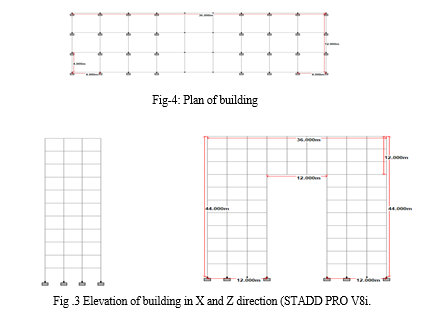
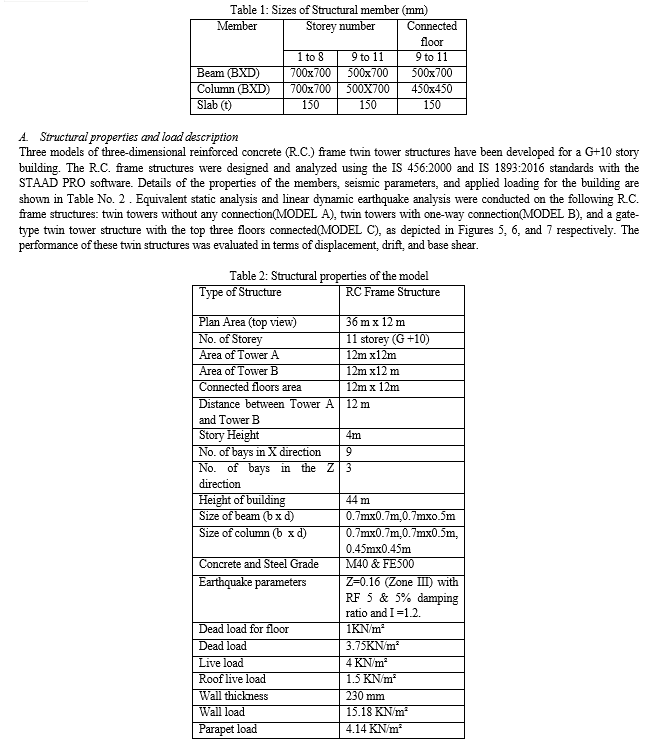
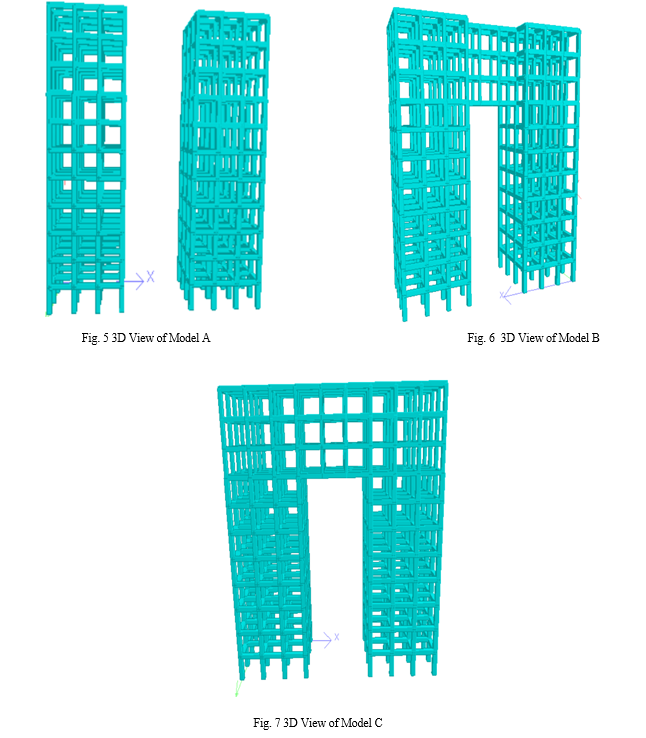
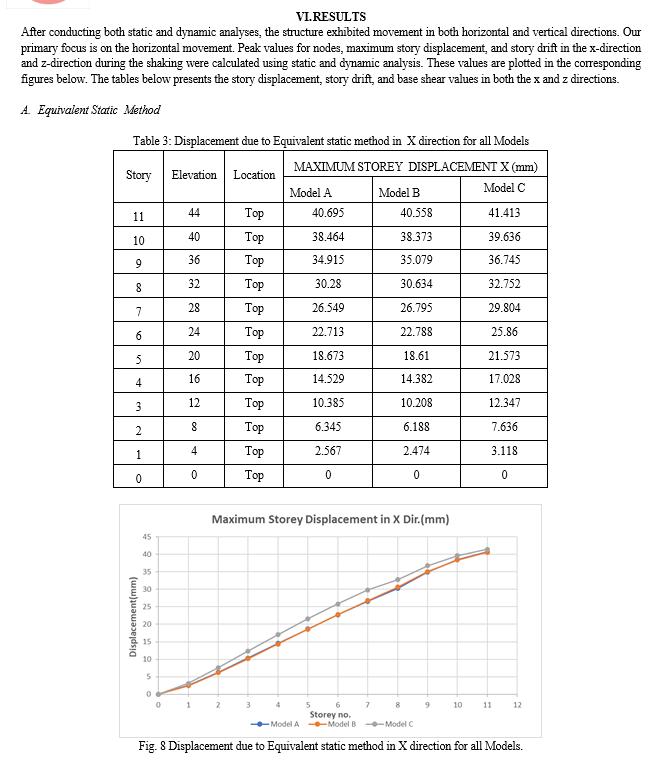

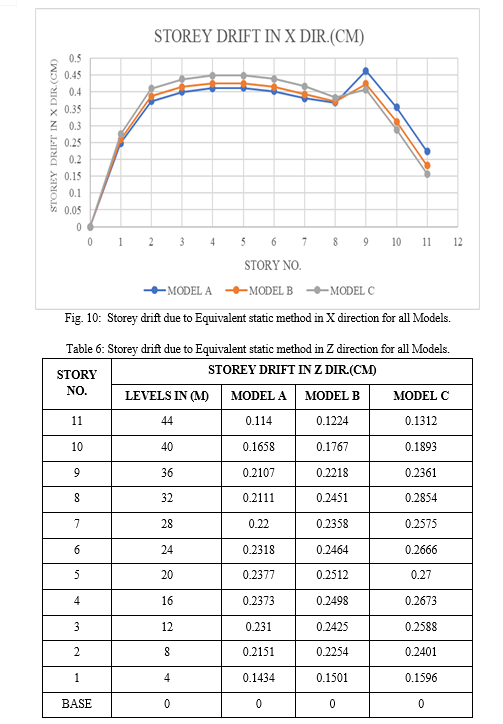
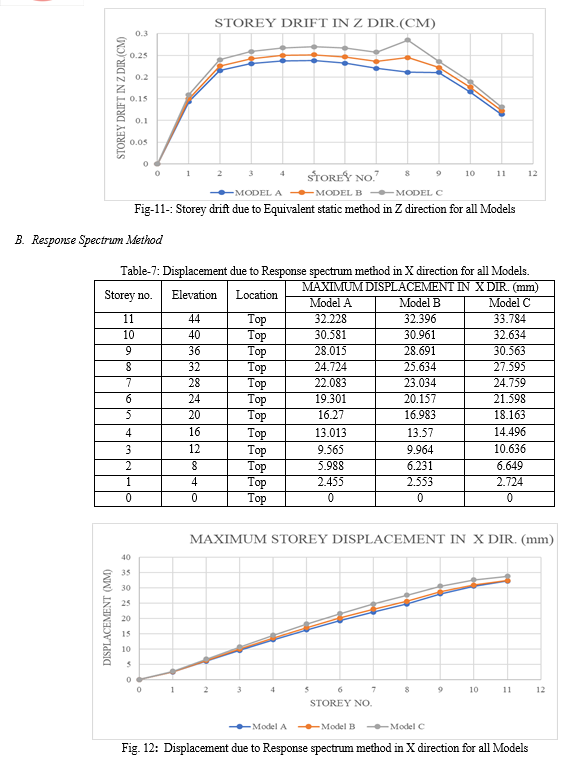
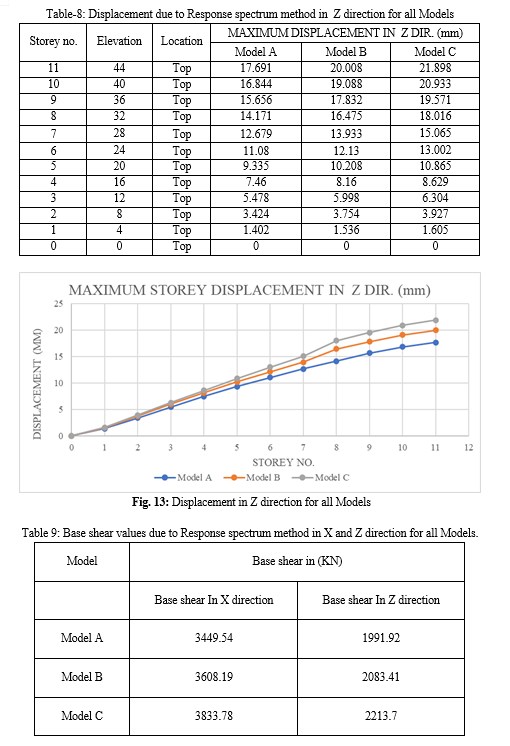

VII. FUTURE SCOPE
The present work involves analyzing the models of a G+10 building using both the equivalent static method and dynamic linear analysis method in software (STAAD.Pro V8i.). The research work can be done by considering the following points:
- For analyzing gate building can be analyzed and designed using the nonlinear dynamic analysis method can be adopted for analyze RC frame structure.
- The study can explore using a structural steel archway to interconnect the Twin Towers.
- The length of the connection can be increased by introducing post-tensioned concrete.
Conclusion
After applying both linear static and dynamic load on the structure, the structure moves in lateral (X and Z direction)and vertical directions. Here, the primary interest on horizontal movement. maximum values for story displacement, story drift, and base shear in the x-direction and z-direction during the shaking were calculated at the top nodes using static and dynamic analysis. These values are plotted in the corresponding figures below. The tables below show the story displacement, drift and base shear values in both the x and z directions. This research delves into the behavior of three distinct structural models: the twin tower without connection, the twin tower with only a one-way connection, and the Gate-type Twin Tower-connected building (where the top three floors are interconnected). Through examination of their response to static and dynamic loads, the following inference can be drawn from the findings: 1) The examination reveals that the displacement of the structure is higher in the gate-type connected twin tower compared to the twin tower without any connections. Conversely, the storey drifts in the x direction of the structure is lower in the gate-type connected twin tower compared to the twin tower without any connections. 2) The displacement values in the X direction, as calculated by the equivalent static method, exhibit a 2.363% increase for model C and a 0.1359% decrease for model B in comparison to model A. 3) The maximum displacement in the Z direction calculated using the linear static method are increases 19.51 % and 11.96% for model C and model B respectively as compared to model A. 4) The maximum displacement in X direction using the linear dynamic method are 4.83% increase for model C and a 0.52% increase for model B as compared to model A. 5) The displacement values in the Z direction, computed using the response spectrum method, show an 18.75% increase for model C and a 13.10% increase for model B compared to model A. 6) The storey drift values resulting from the equivalent static lateral force method in the X direction decreased by 29.85% for Model C and by 18.56% for Model B compared to Model A after connecting floors. 7) The storey drift values resulting from the equivalent static lateral force method in the Z direction increased by 15.09% for Model C and by 7.37% for Model B compared to Model A. The base shear values in both the X and Y directions increased by 11.14% for Model C and by 4.60% for Model B when compared to Model A. 8) The analysis indicates that structural responses to the gate building show both decreases and slight increases in various cases when compare to without connected buildings. So By connecting twin tower buildings, not only is an innovative architectural design achieved, but also a roadway between the towers can also be provided, addition of the horizontal space at the top floors after connecting the towers can also be used for residential, commercial and office accommodation purposes.
References
[1] LIU Liang-kun, Damping performance analysis of the connected structure with the energy-dissipation story, Engineering mechanics, June 2021. [2] Peng Fusong, Zhiang Li, Seismic response analysis of connected dual-tower isolated structure under three-dimensional earthquakes, Ain Shams Engineering Journal,2024,102538. [3] V.N. Bhinde, Dynamic Analysis of Regular Twin Tall RCC Structure with Various Sizes of Links at Most Effective Location. JETIR ,June 2020. [4] Guo Wei, “Seismic performance assessment of a super high-rise twin-tower structure connected with rotational friction negative stiffness damper and lead rubber bearing”, Soil Dynamics and Earthquake Engineering, Volume 152, January 2022, 107039. [5] Wei Guo, Z. Zhai,“Shaking table test and numerical analysis of an asymmetrical twin-tower super high-rise building connected with long-span steel truss”. The Structural Design of Tall and Special Buildings (2019). [6] S. Chaurasiya and S. Jamle, “Determination of Efficient Twin Tower High Rise Building Subjected to Seismic Loading” International Journal of Current Engineering and Technology,(2018) . [7] Imad S. Abbood, “Seismic response analysis of linked twin tall buildings with structural coupling” International Journal of Civil Engineering and Technology (IJCIET) 2018, pp. 208–219. [8] S. Mahmoud, “Horizontally connected high-rise buildings under earthquake loadings”, Ain Shams Engineering Journal, 2019, p227-241. [9] Wei-Feng Qin,“Characteristics of wind loads on Twin Tower structure in comparison with single tower” Engineering Structures (2021) [10] F. Meng(2022),“Analysis of horizontal vibration characteristics of unequal height twin towers of rigid connected structure”, Journal of Building Engineering. [11] J. Song, K. Tse , Dynamic characteristics of wind-excited linked twin buildings based on a 3-D analytical model, Engineering Structures 2014, P 169-181. [12] K. Tse, J. Song, Modal properties of twin buildings with structural coupling at various locations, proc.The Eighth Asia-Pacific Conference on Wind Engineering, December 10–14, 2013, Chennai, India. [13] R. Pahadiya, A Pal,“Determination of Efficient Height Combination of Twin Tower under Seismic Loading”, International Journal of Advanced Engineering Research and Science ,(2020). [14] S. Pastariya,“Analysis of triangular tower on building subjected to seismic loads with different positions”, International Journal of Engineering Applied Sciences and Technology(2020), [15] K. R. Raju,“Analysis of tall building subjected to wind and seismic loads”, National Conference on Emerging Technologies in Civil Engineering(2013). [16] J. P. Moehle “Seismic analysis, design, and review for tall buildings” The structural design of tall and special buildings, Struct (2007). [17] T Kulkarni., “Analysis and Design of High-Rise Building Frame using STAAD PRO”, International Journal of Research in Engineering and Technology(2016). [18] Thakor V. K. Sureshbhai, “Behaviour of multi-story twin structure connection of the beams at a different level” International Research Journal of Engineering and Technology (2023). [19] T. Jayakrishna, “Seismic analysis of regular and irregular multi-story buildings by using staad-pro.”,(IJCIET). [20] Shruti Nagar, Dr. S Maru “Seismic Analysis of Twin Tower Structures”, International Journal for Research in Applied Science & Engineering Technology (IJRASET) Volume 9 Issue X Oct 2021.
Copyright
Copyright © 2024 Akash Asim Gain, Prof. Shilpa Saamrutwar. This is an open access article distributed under the Creative Commons Attribution License, which permits unrestricted use, distribution, and reproduction in any medium, provided the original work is properly cited.

Download Paper
Paper Id : IJRASET62801
Publish Date : 2024-05-27
ISSN : 2321-9653
Publisher Name : IJRASET
DOI Link : Click Here
 Submit Paper Online
Submit Paper Online

